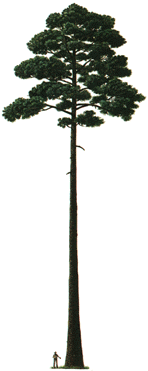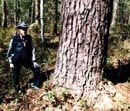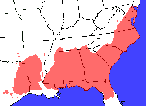
Representative painting of an old-growth tree on the floodplain at Congaree Swamp National Monument, SC (4).

Branch with foliage and cones, near Congaree Swamp, SC [C.J. Earle, Mar-1999].

Bark of a tree in Congaree Swamp, SC. Rule is 15 cm long [C.J. Earle, Mar-1999].

A typical tree in the Congaree Swamp forest: 116 cm dbh [C.J. Earle, Mar-1999].
Common Names
Loblolly pine (1), North Carolina pine, oldfield pine, bull pine, rosemary pine.Taxonomic notes
Description
"Trees to 46 m; trunk to 160 cm diam., usually straight, without adventitious shoots; crown broadly conic to rounded. Bark red-brown, forming square or irregularly rectangular, scaly plates, resin pockets absent. Branches spreading-ascending; twigs moderately slender (to ca. 1 cm thick), orangish to yellow-brown, aging darker brown, rough. Buds lance-cylindric, pale red-brown, 1-1.2(1) cm, mostly less than 1 cm broad, slightly resinous; scale margins white-fringed, apex acuminate. Leaves 2-3 per fascicle, ascending to spreading, persisting 3 years, (10)12-18(23) cm × 1-2 mm, straight, slightly twisted, pliant, deep yellow-green, all surfaces with narrow stomatal lines, margins finely serrulate, apex acute to abruptly conic-subulate; sheath 1-2.5 cm, base persistent. Pollen cones cylindric, 20-40 mm, yellow to yellow-brown. Seed cones maturing in 2 years, shedding seeds soon thereafter, not persistent, solitary or in small clusters, nearly terminal, symmetric, lanceoloid before opening, narrowly ovoid when open, 6-12 cm, mostly dull yellow-brown, sessile to nearly sessile, scales without dark border on adaxial surface distally; apophyses dull, slightly thickened, variously raised (more so toward cone base), rhombic, strongly transversely keeled; umbo central, recurved, stoutly pyramidal, tapering to stout-based, sharp prickle. Seeds obdeltoid; body 5-6 mm, red-brown; wing to 20 mm. 2n=24" (1).Range
USA: New Jersey, Delaware, Maryland, Virginia, North Carolina, Tennessee, South Carolina, Georgia, Florida, Alabama, Mississippi, Louisiana, Arkansas, Oklahoma, and Texas at 0-700 m elevation. Habitat mesic lowlands and swamp borders, to dry uplands (1).Big Tree
Diameter 152 cm, height 45 m, crown spread 25 m, located in Warren, AR (2). The largest tree in South Carolina, in Congaree National Monument, South Carolina, has a dbh of 152 cm, height 44 m, stem volume 42 m3. Other trees in the Congaree attain heights of as much as 48.8 m, the tallest reported for the species (3).Oldest
Dendrochronology
Ethnobotany
In the southeast US, P. taeda is commonly used in plantation forestry, along with P. elliottii and P. echinata. Commercially, it is a valuable pulpwood and timber species (1).Observations
One of the best places to see old-growth loblolly pines is Congaree Swamp National Monument, South Carolina, where the trees grows as emergents approximately 46 m tall above a subtropical broadleaf floodplain forest canopy, itself said to be the tallest such canopy in the northern hemisphere (3).Remarks
Originally most races of Pinus taeda were in the lowlands. Following disturbance of the natural vegetation after settlement by Europeans, the species spread to fine-textured, fallow, upland soils, where it now occurs intermixed with P. echinata and P. virginiana. Pinus taeda frequently forms hybrids with P. echinata and P. palustris (P. × sondereggeri H.H. Chapman) (1).Citations
(1) Kral in Flora of North America online.(2) American Forests. 1996. The 1996-1997 National Register of Big Trees. Washington, DC: American Forests.
(3) Telephone communication 14-Nov-1998 from Robert Van Pelt, who measured these trees in November 1998.
(4) National Park Service. 1995. Congaree Swamp Official Map and Guide. Washington, DC: U.S. Government Printing Office [Paintings by John Dawson].
(5) Burns, R.M. and B.H. Honkala. 1990. Silvics of North America, Vol. 1, Conifers. Washington DC: U.S.D.A. Forest Service Agriculture Handbook 654. http://willow.ncfes.umn.edu/silvics_manual/Table_of_contents.htm.
See also:
Anantha M. Prasad and Louis R. Iverson. 1999. A Climate Change Atlas for 80 Forest Tree Species of the Eastern United States. http://www.fs.fed.us/ne/delaware/atlas/. Delaware, Ohio: USFS Northeastern Research Station.
The FEIS database.
back | Pinus | Pinaceae | home
This page is from the Gymnosperm Database
URL: http://www.geocities.com/~earlecj/pi/pin/taeda.htm
Edited by Christopher J. Earle
E-mail:earlecj@earthlink.com
Last modified on 21-Nov-1999
